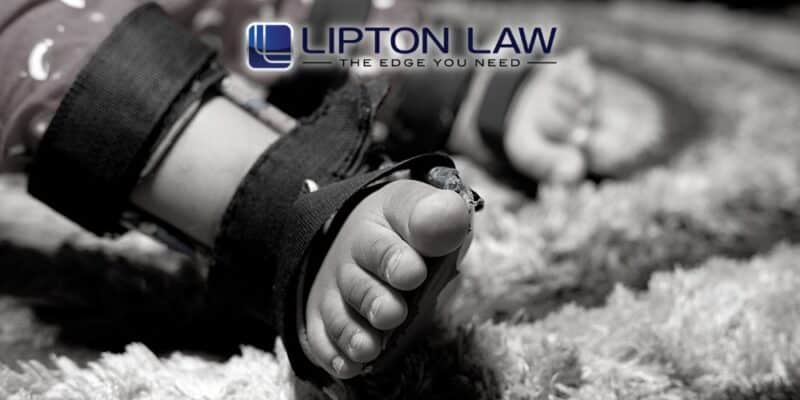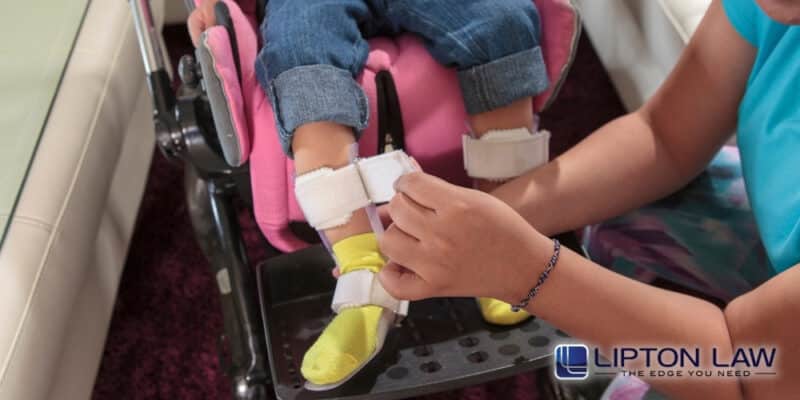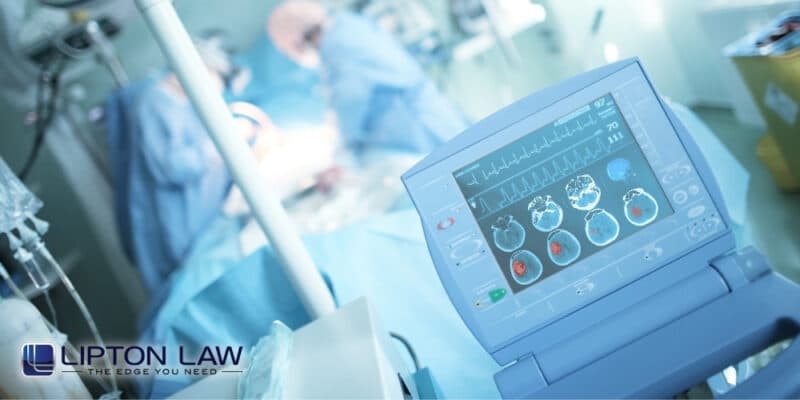Michigan Cerebral Palsy Lawyer

Most parents never expect that medical mistakes will impact their newborn, let alone that those mistakes will impact their child’s future. Any expectant mother or father will hope that the labor and delivery process will go smoothly, but that is not always the case. When doctors engage in medical malpractice during the birthing process, even simple errors can result in birth injuries, such as newborn cephalohematoma and even cerebral palsy. If your child’s cerebral palsy resulted from medical negligence, you need a Michigan cerebral palsy lawyer on your side.
At Lipton Law, we understand how devastating a birth injury can be for families. Developing cerebral palsy as a result of medical malpractice can completely change the trajectory of both your life and your child’s life. You and your child both deserve compensation for the birth trauma caused by a medical mistake. Our Michigan cerebral palsy lawyers are here for you. To schedule a free consultation with us about your cerebral palsy case, please call our law firm at 248-557-1688 today.
Top-Rated Michigan Birth Injury Lawyers
If you’re in need of a top medical malpractice lawyer in Southfield, Lipton Law is here for you. Our personal injury lawyers have extensive experience advocating on behalf of parents and children after a medical error causes a birth injury. For decades, we have represented Michigan citizens in various personal injury and cerebral palsy cases.
Learning that your child suffers from cerebral palsy is often enough to put tremendous emotional and financial strain on a family. A child diagnosed with cerebral palsy may need extensive medical care, and you may watch as your medical expenses quickly stack up. Hiring a Michigan cerebral palsy attorney can greatly increase your chances of success when you file a medical malpractice lawsuit.
Don’t wait to contact our Michigan cerebral palsy attorneys. Call our office today and schedule your free initial consultation with us.
What Is Cerebral Palsy?

Cerebral palsy is actually a group of disorders primarily affects one’s movement, posture, balance, and muscle tone. It is classified as a motor disability, and is the most common childhood motor disability. The word cerebral means that it deals with the brain. Palsy refers to muscle weakness or difficulty in movement. It can be a birth injury, but it is not always a result of medical negligence.
Is Cerebral Palsy a Birth Injury?
Yes, cerebral palsy is one of many types of birth injuries. Usually, cerebral palsy cases result from a lack of oxygen to the brain during birth. When an infant suffers from a lack of blood flow or oxygen to the brain, this is known as hypoxic ischemic encephalopathy.
Cerebral palsy is also the most common type of serious birth injury. There are a few risk factors for this condition, including going through difficult or prolonged childbirths. This condition’s presentation and symptoms vary depending on each individual, as well as the extent of the brain damage suffered by the child.
Mild and moderate cases of cerebral palsy may show only minor limps or impaired movements. Severe cerebral palsy, however, can completely disable a child and confine them to a wheelchair for the rest of their lives. They may also require frequent medical treatment, which can lead to expensive medical bills for parents.
Does Cerebral Palsy Get Worse Over Time?
No. Cerebral palsy is not a progressive condition, which means that it does not worsen with time. However, it is also not possible to reverse the effects of cerebral palsy. Alongside a child’s disability, movement problems, and abnormal muscle tone, they could suffer seizures, speech problems, hearing impairment, and vision problems.
Although a child’s condition itself may not change over time, the symptoms can somewhat vary. Cerebral palsy symptoms will nearly always involve problems with posture and body movement. The cerebral palsy life expectancy generally corresponds with the severity of the condition.
What Causes Cerebral Palsy?

The specific cause of cerebral palsy is brain damage that occurs before, during, or just after birth. One common cause of brain damage occurs when the baby’s brain doesn’t get enough oxygen. Hypoxic ischemic encephalopathy is one condition that can restrict the flow of oxygen to the brain.
Depending on the exact type and location of the brain damage, a child can develop one of several different forms of cerebral palsy. Below, we outline several common sources of brain damage that can result in cerebral palsy.
- Brain trauma: Any head injury or brain trauma during the labor and delivery process, or during the first few years of a child’s life, can lead to cerebral palsy.
- Asphyxia: This is a condition caused by a lack of oxygen to the brain. Specific causes of asphyxia in newborns include uterine rupture, pinched umbilical cord, and early placenta detachment.
- Hemorrhages: This is also known as brain bleeding. When blood vessels in the brain rupture, this can lead to a buildup of pressure on the brain. Pressure on the brain can also cause cephalohematoma.
- Having a low birthweight: In general, children who have a low birth weight are at a higher risk of birth complications than other children.
- Genetic mutations: Medical experts are still researching the link between cerebral palsy and genetic mutations. Approximately 14% of all CP cases share a link with rare genetic mutations.
Medical Errors That Cause Cerebral Palsy
Approximately 70% of all cerebral palsy cases occur as a result of a birth injury. Medical professionals can make mistakes that cause an infant to develop cerebral palsy. Any of the following medical mistakes could lead to a CP diagnosis.
- Failing to treat seizures
- Failure to detect and treat umbilical cord prolapse
- Improperly using birth assisting tools, such as forceps or a vacuum extraction device
- Leaving a child in the birth canal for too long
- Delaying a cesarean section for too long
- Failing to address complications during pregnancy, labor, or delivery
What Are the Symptoms of Cerebral Palsy?
The symptoms of CP vary greatly from person to person. One child may have symptoms that affect their entire body, while another may only experience CP symptoms in one or two limbs. Below, we outline the most common symptoms of CP.
- Spasticity, which is characterized by muscle stiffness and exaggeration of reflexes
- Abnormal muscle tone
- Ataxia, which is a lack of coordination of the muscles and balance
- Stiff muscles but normal reflexes
- Tremors
- Having difficulty with fine motor skills and coordination
- Slow movements
- Drooling or difficulty swallowing
- Difficulty speaking in general
- Developmental delays in speech
- Difficulty eating, chewing food, or sucking on a straw
- Stunted growth
- Intellectual disability
- Difficulty learning
- Delays in certain motor skill milestones
- Epilepsy and seizures
- Hearing problems
- Bowel and bladder problems
- Mental health problems
- Vision or hearing problems
Cerebral Palsy Risk Factors
According to the National Institutes of Health, the risk factors for developing cerebral palsy include the following.
- Newborn jaundice
- Seizures in infants
- Preterm births or those with a low birth weight
- Certain infertility treatments
- Multiple gestation births
- Fever in the mother during pregnancy
- Certain infections during pregnancy
- Toxic exposure to certain chemicals
- Certain medical conditions in the mother
- Non-matching blood factor
- Labor and delivery problems
- Failing to get certain vaccinations
How to Diagnose Cerebral Palsy

Diagnosing cerebral palsy requires frequent monitoring of infants and young children. The signs of CP are not always apparent right away. Doctors will usually begin by watching your child’s symptoms, monitoring their development and growth, looking at their medical records and post-birth records, and conducting a physical exam. If they suspect CP, they will likely refer you to a medical professional who specializes in brain conditions in children.
Your doctor may also order certain imaging tests, such as the following.
- MRIs
- Cranial ultrasounds
- Electroencephalograms (EEGs)
If you suspect that a medical mistake caused your child’s CP, speak with our Michigan cerebral palsy attorneys as soon as possible.
How to Treat Cerebral Palsy
As we mentioned before, cerebral palsy has no cure. However, there are ways to treat and manage the condition. Many individuals with cerebral palsy require lifelong medical care. This medical care aims to improve the daily functioning of the child. You’ll likely need to work with a team of medical experts in order to address all your child’s needs. Treatment and management techniques often include the following.
- Injections in the nerves or muscles
- Muscle relaxants
- Physical therapy
- Recreational therapy
- Occupational therapy
- Speech or language therapy
- Rhizotomy treatments
- Orthopedic surgery procedures
- Other medications as needed
Is There a Cure for Cerebral Palsy?
No. However, this does not mean that a child with cerebral palsy cannot lead a fulfilling life. Treatment and management of the condition with the help of a specialized medical team can ensure that your child does not suffer further complications. However, many of these treatments and surgeries are incredibly expensive. Many parents and families simply don’t have the means to pay for these treatments. We recommend speaking with a Michigan birth injury attorney to explore your legal help options.
What Are Legal Options for Children with Cerebral Palsy?

As a parent or family member of a child with cerebral palsy, you may have legal options. If your child’s doctor made a medical mistake that caused their cerebral palsy, you may be able to seek compensation through a cerebral palsy lawsuit. Medical negligence from a doctor or other hospital staff member could lead to expensive medical bills, as well as pain and suffering for your child.
As the family of a child with cerebral palsy, you deserve compensation for the actions of a negligent medical professional. Work with a Michigan cerebral palsy lawyer to give your case the best possible chance of success.
How Do You Prove a Cerebral Palsy Lawsuit?
When you file a cerebral palsy lawsuit, you’ll need extensive evidence to prove medical malpractice. Medical malpractice laws in Michigan require you to prove the following.
- There was a doctor-patient relationship in which the doctor owed the parent and the infant a certain standard of care.
- The doctor violated that standard of care.
- An injury (cerebral palsy) occurred as a result of that breach.
- The breach resulted in actual damages to the child.
Medical evidence is your best friend in cases like these. You’ll need as many medical records as you can round up, including birth records and pre-natal records. Seek legal help as soon as possible for your case. Medical malpractice lawsuits have strict time deadlines, but working with an attorney will ensure that you don’t miss these deadlines.
Contact a Cerebral Palsy Lawyer in Michigan Today
At Lipton Law, we believe that both parents and children who are victims of medical malpractice deserve justice. A Michigan cerebral palsy lawyer with our firm will examine the facts of your case, gather evidence and information to support your claim, and take your case to court if necessary. We have a skilled team of litigators at your disposal, so you can rest assured that we will fight for the legal rights of your family. To schedule your free consultation with us, please call our office at 248-557-1688 today.
Types of Medical Malpractice
Practice Areas

